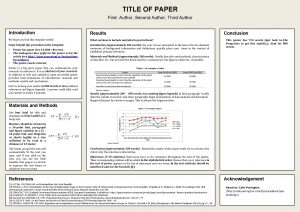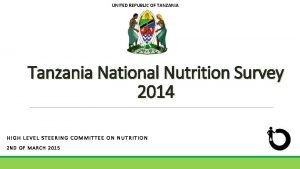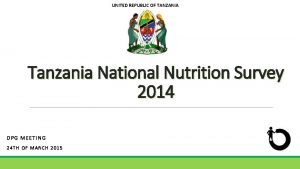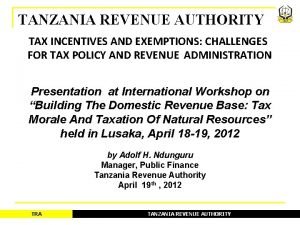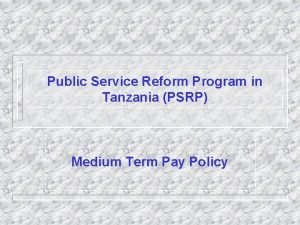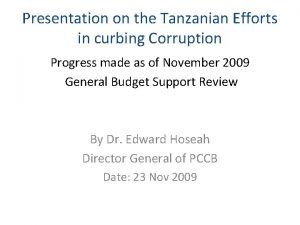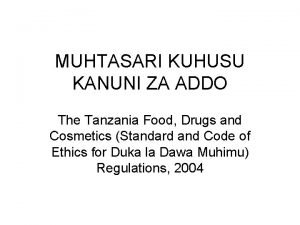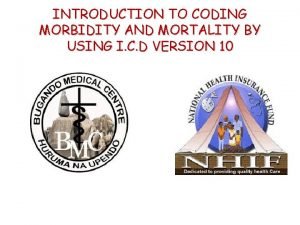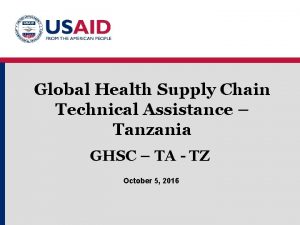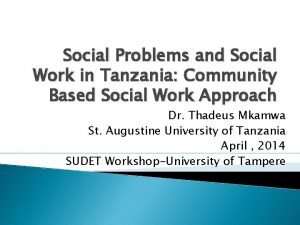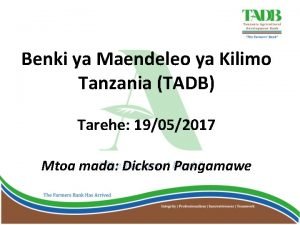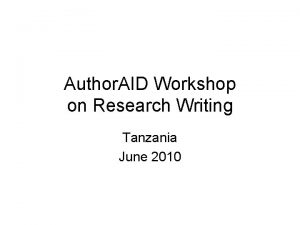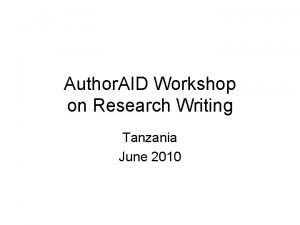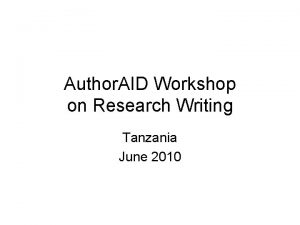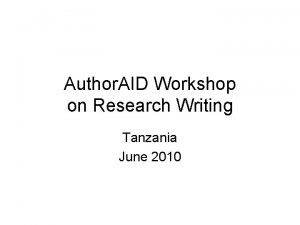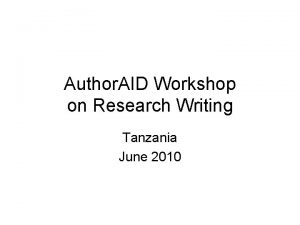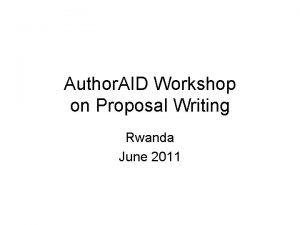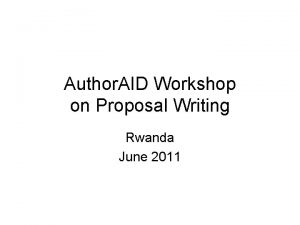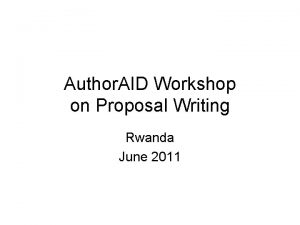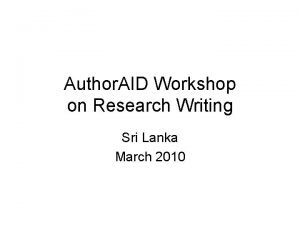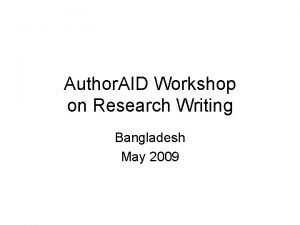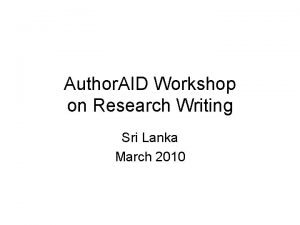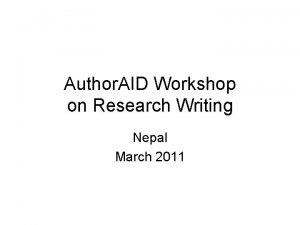Author AID Workshop on Research Writing Tanzania June






















- Slides: 22

Author. AID Workshop on Research Writing Tanzania June 2010

Publishing a Journal Article: An Overview of the Process Barbara Gastel, MD, MPH Texas A&M University bgastel@cvm. tamu. edu

Overview • • Deciding what (or when) to publish Identifying a target journal Following the journal’s instructions Submitting the paper Understanding the decision process Revising a paper Answering queries Reviewing proofs

Deciding What (or When) to Publish • Some factors to consider: quality of the work, extent of the work, interest to others • Suggestions: – Seek guidance in this regard from others in your field who are more experienced in publishing journal articles. – Present your work orally first. Doing so can help in deciding whether the work is publishable and in shaping the paper.

Identifying a Target Journal • Decide early (before drafting the paper). Do not write the paper and then look for a journal. • Look for journals that have published work similar to yours. • Consider journals that have published work you cite.

Some Factors to Consider • • Audience Prestige Access Impact Publication time Quality of reproduction Likelihood of acceptance

Some Research • Frank E. Authors’ criteria for selecting journals. JAMA 1994; 272: 163 -164. • Presents findings from one medical school • Interesting: criteria for differed for first and later submissions of a paper

Findings “On a scale of 1 (unimportant) to 6 (very important), respondents ranked factors affecting initial manuscript submission to a journal in the following descending order (mean values are reported): the journal's prestige, 5. 2; the makeup of the journal's readership, 4. 8; whether the journal usually publishes articles on the topic, 4. 8; the likelihood of manuscript acceptance, 4. 4; the size of journal circulation, 4. 1; the rapidity of manuscript turnaround, 4. 1; the existence of good editors, 3. 9; the likelihood of useful reviewer suggestions, 3. 4; a history of having published in that journal previously, 3. 4; colleagues' recommendations, 3. 1; the likelihood of useful biostatistical suggestions, 2. 6; the existence of editors who are personally known to the author, 2. 1; and the likelihood of press attention, 1. 9. For subsequent submissions, the most important factors were the likelihood of manuscript acceptance (5. 0) and whether the journal usually publishes articles on the topic (4. 7). ”

Journals’ Instructions to Authors • Usual locations: in the journal and on the journal’s Web site • A collection of instructions from biomedical journals: http: //mulford. meduohio. edu/instr/ • Other examples of instructions to authors

Using the Journal’s Instructions • Read the instructions to authors before starting to prepare your paper. • Consult the instructions while preparing your paper. • Check the instructions again before submitting your paper.

Some Questions the Instructions May Answer • What categories of article does the journal publish? • What is the maximum length of articles? • What is the maximum length of abstracts? • Does the journal have a template for articles? If so, how can it be accessed? • What sections should the article include? What are the guidelines for each?

Some Questions (cont) • What guidelines should be followed regarding writing style? • How many figures and tables are allowed? What are the requirements for them? • In what format should references appear? Is there a maximum number of references? • In what electronic format should the paper be prepared?

Beyond the Instructions • Look at some recent issues of the journal. Doing so can help you gear your paper to the journal.

Submitting the Paper • Traditional submission (by mail) • Electronic submission • Inclusion of a cover letter (conventional or electronic)—see, for example, http: //www. lwwonline. com/pt/re/lwwonline/cover Checklist. htm; jsessionid=Jj. PVKv 4 h 9 n. Gpy. WB 6 fh 6 j. Y 54 JZ 8 wjzmh 4 n. P 5 sj. Lv. X 2 m. YZk. ZThv 5 Ns!858031623!181195628!8091!-1 • Completion of required forms

Some Categories of Editors at Journals • Helpful to know because you might interact with each • Main categories: – Editor-in-chief (and sometimes associate editors etc)—concerned mainly with content – Managing editor(s)—concerned mainly with administration of the journal – Manuscript editor(s)—improve the writing and maintain a consistent style

Initial Screening by the Journal • For appropriateness of subject matter • For compliance with instructions • For overall quality (sometimes)

Peer Review • Evaluation by experts in the field • Purposes: – To help the editor decide whether to publish the paper – To help the authors improve the paper, whether or not the journal accepts it

The Editor’s Decision • Based on the peer reviewers’ advice, the editor’s own evaluation, the amount of space in the journal, other factors • Options: – Accept as is (rare) – Accept if suitably revised – Reconsider if revised – Reject

Revising a Paper • Revise and resubmit promptly. • Indicate what revisions were made. – Include a letter saying what revisions were made. If you received a list of requested revisions, address each in the letter. – If requested, show revisions in Track Changes. • If you disagree with a requested revision, explain why in your letter. Try to find a different way to solve the problem that the editor or reviewer identified.

Answering Queries • Queries: questions from the manuscript editor • Some topics of queries: – Inconsistencies – Missing information – Ambiguities – Other • Advice: Respond promptly, politely, and completely yet concisely.

Reviewing Proofs • Proof: copy of typeset material to check • Review the proofs promptly. • Some things to check: – Completeness (presence of all components) – Absence of typographical errors in text and references – Placement of figures and tables – Quality of reproduction of figures • Note: This is not the time to rewrite the paper.

A Final Step Celebrate Publication of Your Paper!
 First author second author third author
First author second author third author Narrative essay quiz
Narrative essay quiz First aid merit badge first aid kit
First aid merit badge first aid kit Greenhill medical centre
Greenhill medical centre Tanzania national nutrition survey 2018
Tanzania national nutrition survey 2018 Tanzania national nutrition survey 2018
Tanzania national nutrition survey 2018 Tanzania scouts association
Tanzania scouts association Tax incentives in tanzania
Tax incentives in tanzania Tcco tanzania
Tcco tanzania National health laboratory tanzania
National health laboratory tanzania Psrp
Psrp Mission of pccb in tanzania
Mission of pccb in tanzania Jinsi ya kuhakiki cheti cha addo
Jinsi ya kuhakiki cheti cha addo Nhif tanzania disease codes
Nhif tanzania disease codes Tanzania urbaniseringsgrad
Tanzania urbaniseringsgrad Ghsc tanzania
Ghsc tanzania Origins of community development
Origins of community development Bei ya kahawa
Bei ya kahawa Aga khan foundation tanzania
Aga khan foundation tanzania Historical background of good governance in tanzania
Historical background of good governance in tanzania What are the social problems in tanzania?
What are the social problems in tanzania? Tanzania investment centre
Tanzania investment centre Bank ya kilimo tanzania
Bank ya kilimo tanzania
